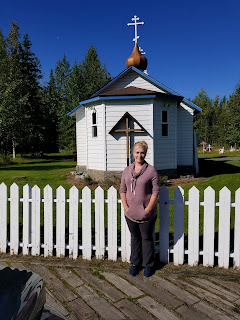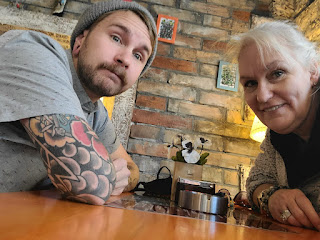Mount Vernon
What better trip to write about on Independence Day than
George Washington’s Mount Vernon.
 The land where Mount Vernon stands was in George Washington’s
family since his great grandfather’s time 1674 and was originally called Little
Hunting Creek Plantation. In 1735 when George Washington was just 3 years old
his father moved the family to the property and a modest home was built. When George
Washington’s half-brother Lawrence inherited the property he renamed it Mount
Vernon in honor of Admiral Edward Vernon his commanding officer in the British
Royal Navy. When George Washington began leasing and then inherited the
plantation he expanded the home raising the roof making it two and a half
stories high and added north and south wings, a cupola and a piazza. The
mansion is 11,028 square feet in size. The exterior of the mansion looks like
it is made of stone, but in reality it is wood that was then painted and had
sand thrown on it to give it a more impressive and expensive look, it truly
does have the impactful look of sandstone.
The land where Mount Vernon stands was in George Washington’s
family since his great grandfather’s time 1674 and was originally called Little
Hunting Creek Plantation. In 1735 when George Washington was just 3 years old
his father moved the family to the property and a modest home was built. When George
Washington’s half-brother Lawrence inherited the property he renamed it Mount
Vernon in honor of Admiral Edward Vernon his commanding officer in the British
Royal Navy. When George Washington began leasing and then inherited the
plantation he expanded the home raising the roof making it two and a half
stories high and added north and south wings, a cupola and a piazza. The
mansion is 11,028 square feet in size. The exterior of the mansion looks like
it is made of stone, but in reality it is wood that was then painted and had
sand thrown on it to give it a more impressive and expensive look, it truly
does have the impactful look of sandstone.
Every room inside this grand house it full of detail and impeccable
craftsmanship, perhaps the most awe-inspiring room is The New Room as Washington
called it as it was the last addition made to the mansion. This room served as
a “salon” similar to those found in 18th century British homes,
meaning it served a variety of functions to include receiving visitors and as a
place to hold large parties and dinners. This room alone is larger than most homes would have been during
that time frame.
Along with the new room this mansion boasts two parlors, a
central passage where visitors where greeted when they arrived and entertaining
took place during the hot Virginia summers, dining rooms, a study and numerous
bedrooms. Our tour guide pointed out that during this time period it was not
unusual for guests to arrive and expect to have a room for extended
periods of time, this mansion would have been full of guests at almost all
times.
In the Washington’s bedchamber there is a bed that was purchased
in the 1790’s, it is just over 6 foot 6 inches long making it large enough for the6 foot 2 inch George Washington to sleep comfortably. It was in this
bedchamber that George Washington died on 14 December 1799. Upon his death
Martha closed up this room and moved to her bedroom on the third floor. Today
some visitors report seeing George Washington’s ghost in this bedroom.
On the back of the house overlooking the Potomac River is a
large piazza that runs the full length of the mansion; this space was often
used for afternoon tea as it was a cool space due to the river breezes. Today
it continues to offer spectacular views of vast green space and the river
running in the background.
 |
| Back Piazza |
Outside the home the slave quarters, blacksmith shop and
other outbuildings were located. During its peak Mount Vernon housed over 300 slaves.
George Washington became a slave owner at the age of 11 when he was willed 10
slaves by his father Augustine, over his life George Washington purchased more
slaves and also acquired dower slaves from Martha Washington’s first husband
Daniel Parke Custis’s estate. Sources offer different accounts of George
Washington’s treatment of his slaves with some neighbors reporting that he
treated them with more severity than other men and others saying he was far
more human. It does appear that over time George Washington’s stance on slavery
changed and while he never publicly supported abolishing slavery he did leave
directions in his will that 123 slaves were to be freed after the death of his
wife Martha. George Washington left instructions in his will that any elderly
slaves or those who were sick and unable to work were to be supported by the
estate for the remainder of their lives. Sadly this did not free all of the
slaves at Mount Vernon as neither George nor Martha could by law free the dower
slaves from the Custis estate and upon Martha’s death they reverted back to the
estate and were divided among her grandchildren. After the death of George
Washington, Martha Washington was advised to set all of the non-dower slaves
free and in December 1880 she signed a deed of manumission in regards to these
slaves. They were finally granted their freedom on 1 January 1801.
On the grounds there
stands a memorial to these men, women and children who were kept in slavery, it is located
at the site of the cemetery where many slaves were buried. Because many graves
would have been unmarked and those that were marked may have been lost over
time there is no way to know for sure how many bodies call this their final
resting place. Visitors to the plantation have reported hearing and seeing
things in this area to include singing and lights and shadows moving between
the trees.
At age 67 while George Washington lay dying he made a request to his
secretary Tobias Lear asking him to ensure he had a decent burial and that he
not be placed in the tomb before at least three days had past. This was a time
when people had been known to “come back from the dead” as medical technology was
not as it is today and it was possible to not be able to detect a heartbeat or
breathing of someone who had not yet truly passed. To ensure this was not the
case George Washington lay in a frozen state for several days due to the cold
weather. A good friend and physician William Thornton had been called to try and
save George Washington when he became ill. Thornton was distraught to learn
that George Washington had died prior to his arrival and composed a plan to resurrect
him.
William Thornton proposed that first they thaw him out in
cold water and then use blankets to create friction to give him warmth at the
same time opening up his lungs with the help of tracheas to inflate them and
produce air, then providing a transfusion of warm lambs blood. Martha Washington refused this
offer to attempt a resurrection and George Washington was laid to rest 18 December 1799 on the
property of Mount Vernon as per his last will. In 1830 a disgruntled ex-employee of the plantation attempted to steal George Washington's skull. The next year a new vault was constructed to
replace the original family burial vault and in 1831 George Washington along with his
wife Martha's remains were transferred to this new vault, encased within a within a marble sarcophagus where
they continue to rest today along with other family members










Comments
Post a Comment